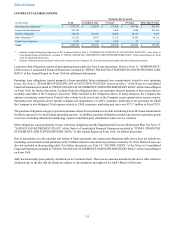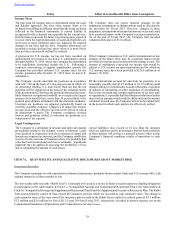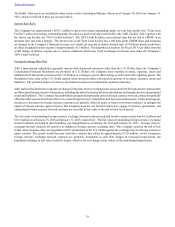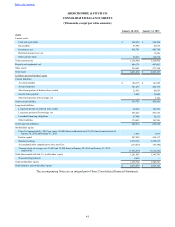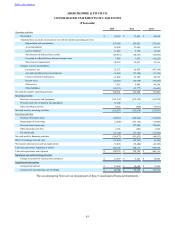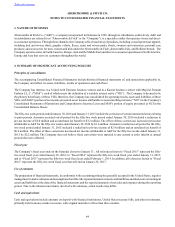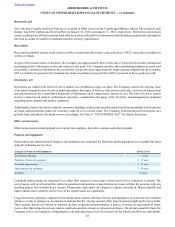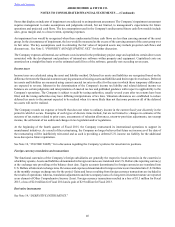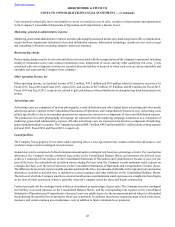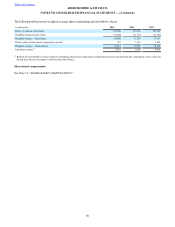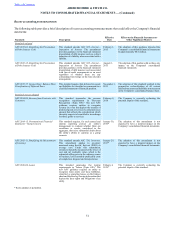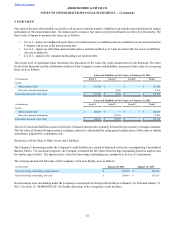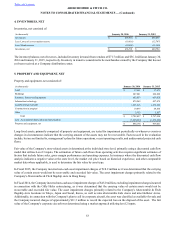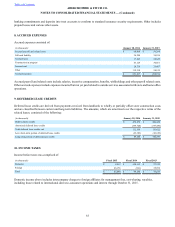Abercrombie & Fitch 2015 Annual Report Download - page 45
Download and view the complete annual report
Please find page 45 of the 2015 Abercrombie & Fitch annual report below. You can navigate through the pages in the report by either clicking on the pages listed below, or by using the keyword search tool below to find specific information within the annual report.
Table of Contents ABERCROMBIE & FITCH CO.
NOTES TO CONSOLIDATED FINANCIAL STATEMENTS — (Continued)
45
Restricted cash
Any cash that is legally restricted from use is recorded in Other Assets on the Consolidated Balance Sheets. The restricted cash
balance was $20.6 million and $14.8 million on January 30, 2016 and January 31, 2015, respectively. Restricted cash includes
various cash deposits with international banks that are used as collateral for customary non-debt banking commitments and deposits
into trust accounts to conform to standard insurance security requirements.
Receivables
Receivables primarily include credit card receivables, construction allowances, value added tax (“VAT”) receivables and other tax
credits or refunds.
As part of the normal course of business, the Company has approximately three to four days of proceeds from sales transactions
outstanding with its third-party credit card vendors at any point. The Company classifies these outstanding balances as credit card
receivables. Construction allowances are recorded for certain store lease agreements for improvements completed by the Company.
VAT receivables are payments the Company has made on purchases of goods that will be recovered as those goods are sold.
Inventories, net
Inventories are valued at the lower of cost or market on a weighted-average cost basis. The Company reduces the carrying value
of inventory through a lower of cost or market adjustment, the impact of which is reflected in cost of sales, exclusive of depreciation
and amortization on the Consolidated Statements of Operations and Comprehensive Income (Loss). The lower of cost or market
reserve is based on an analysis of historical experience, composition and aging of the inventory and management's judgment
regarding future demand and market conditions.
Additionally, as part of inventory valuation, inventory shrinkage estimates based on historical trends from actual physical inventories
are made each period that reduce the inventory value for lost or stolen items. The Company performs physical inventories on a
periodic basis and adjusts the shrink reserve accordingly. See Note 4, “INVENTORIES, NET,” for further discussion.
Other current assets
Other current assets include prepaid rent, current store supplies, derivative contracts and other prepaids.
Property and equipment
Depreciation and amortization of property and equipment are computed for financial reporting purposes on a straight-line basis
using the following service lives:
Category of Property and Equipment Service Lives
Information technology 3 - 7 years
Furnitures, fixtures and equipment 3 - 15 years
Leasehold improvements 3 - 15 years
Other property and equipment 3 - 20 years
Buildings 30 years
Leasehold improvements are amortized over either their respective lease terms or their service lives, whichever is shorter. The
cost of assets sold or retired and the related accumulated depreciation or amortization are removed from the accounts with any
resulting gain or loss included in net income. Maintenance and repairs are charged to expense as incurred. Major remodels and
improvements that extend the service lives of the related assets are capitalized.
Long-lived assets, primarily comprised of leasehold improvements, furniture, fixtures and equipment, are tested for recoverability
whenever events or changes in circumstances indicate that the carrying amount of the long-lived asset might not be recoverable.
These include, but are not limited to, material declines in operational performance, a history of losses, an expectation of future
losses, other than temporary adverse market conditions and store closure or relocation decisions. On at least a quarterly basis, the
Company reviews for indicators of impairment at the individual store level, the lowest level for which cash flows are identifiable.


